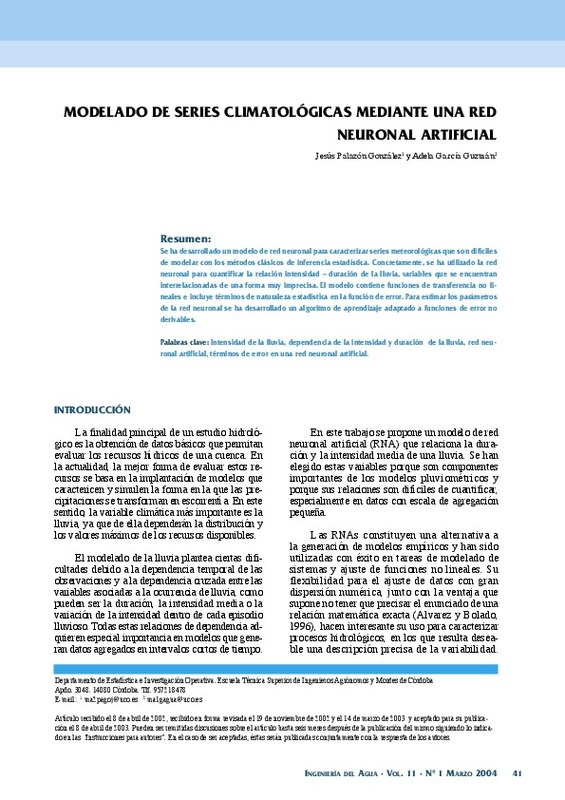Alvarez, J., y S. Bolado (1996). Descripción de los procesos de infiltración mediante redes neuronales artificiales. Ing. Agua. 3: 39 - 46.
ASCE task committee on application of artificial neural networks in hydrology (2000). Artificial neural networks in hydrology, I: preliminary concepts. J. Hydrol. Engng. 5: 115 - 123.
Bárdossy, A. (1998). Generating precipitation time series using simulated annealing. Water Resour. Res. 34: 1737 - 1744.
[+]
Alvarez, J., y S. Bolado (1996). Descripción de los procesos de infiltración mediante redes neuronales artificiales. Ing. Agua. 3: 39 - 46.
ASCE task committee on application of artificial neural networks in hydrology (2000). Artificial neural networks in hydrology, I: preliminary concepts. J. Hydrol. Engng. 5: 115 - 123.
Bárdossy, A. (1998). Generating precipitation time series using simulated annealing. Water Resour. Res. 34: 1737 - 1744.
Cancelliere, A., G. Giuliano, A. Ancarani y G. Rossi (2002). A neural networks approach for deriving irrigation reservoir operating rules. Water Resour. Mgmt. 16: 71 - 88.
Cybenko, G. (1989). Approximations by superpositions of a sigmoidal function. Math. Control, Signals Syst. 2: 303 - 314.
Dibike, Y. B., D. Solomatine y M. B. Abbott (1999). On the encapsulation of numerical hydraulic models in artificial neural network. J. Hydr. Res. 37: 147 - 161.
Eagleson, P. S. (1978). Climate, soil and vegetation (2): The distribution of annual precipitation derived from storm sequences. Water Resour. Res. 14: 713 - 721.
Entakhabi, D., I. Rodríguez Iturbe y P. S. Eagleson (1989). Representation of the temporal rainfall process by a modified Neyman Scott rectangular pulse model: Parameter estimation and validation. Water Resour. Res.25: 295 - 302.
Fine, T. L. (1999). Feedforward neural network methodology. Ed. Springer - Verlag
Freeman, J. A., y D. M. Skapura (1993). Redes neuronales: algoritmos, aplicaciones y técnicas de programación. Ed. Addison - Wesley
French, M. N., W. F. Krajewski y R. R. Cuykendall (1992). Rainfall forecasting in space and time using a neural network. J. Hydrol. 137: 1 - 31.
Funahashi, K. I. (1989). On the approximate realization of continuous mappings by neural networks. Neural Networks 2: 183 - 192.
Goel, N. K., R. S. Kurothe, B. S. Mathur y R. M. Vogel (2000). A derived flood frequency distribution for correlated rainfall intensity and duration. J. Hydrol.228: 56 - 67.
Govindaraju, R. S., y A. Ramachandra Rao (2000). Artificial neural networks in hydrology. Ed. Kluwer Academic Publishers
Hagan, M., y M. Menhaj (1994). Training feedforward networks with the Marquardt algorithm. IEEE Trans. On Neural Networks 5: 989 - 993.
Hecht - Nielsen, R. (1987). Kolmogorov's mapping neural network existence theorem. Proc. Int. Conf. on Neural Networks 3: 11 - 13, IEEE Press.
Hecht - Nielsen, R. (1990). Neurocomputing. Ed. Addison - Wesley
Hilera González, J. R., y V. J. Martínez Hernando (1995). Redes neuronales artificiales. Fundamentos, modelos y aplicaciones. Ed. Ra - Ma
Himmelblau, D. M. (1972). Applied nonlinear programming. Ed. McGraw - Hill
Hornik, K., M. Stinchcombe y H. White (1990). Universal approximation of an unknown mapping and its derivatives using multilayer feedforward networks. Neural Networks 3: 551 - 560.
Hsu, K. L., H. V. Gupta y S. Sorooshian (1995). Artificial neural network modeling of the rainfall - runoff process. Water Resour. Res. 31: 2517 - 2530.
Hsu, K. L., H. V. Gupta, X. Gao y S. Sorooshian (1999). Estimation of physical variables from multichannel remotely sensed imagery using a neural network: application to rainfall estimation. Water Resour. Res. 35: 1605 - 1618.
Hutchinson, M. F. (1990). A point rainfall model based on a three state continuous Markov occurrence process. J. Hydrol. 114: 125 - 148.
Istok, J. D. y L. Boersma (1989). A stochastic cluster model for hourly precipitation data. J. Hydrol. 106: 257 - 285.
Johansson, E. M., F. U. Dowla y D. M. Goodman (1992). Backpropagation learning for multilayer feedforward neural networks using the conjugate gradient method. Int. J. Neural Syst. 2: 291 - 301.
Kao, J. J. (1996). Neural net for determining DEM based model drainage pattern. J. Irrigation and Drainage Engng. 122: 112 - 121.
Kolmogorov, A. N. (1957). On the representations of continuous functions of many variables by superpositions of continuous functions of one variable and addition. Dokl. Akad. Nauk USSR 114: 953 - 956.
Kurkova, V. (1991). Kolmogorov's theorem is relevant. Neural Computation 3: 617 - 622.
Leshno, M., V. Lin, A. Pinkus y S. Schocken (1993). Multilayer feedforward networks with a nonpolynomial activation function can approximate any function. Neural Networks 6: 861 - 867.
Maier, H. R., y G. C. Dandy (1999). Empirical comparison of various methods for training feedforward neural networks for salinity forecasting. Water Resour. Res.35: 2591 - 2596.
Martín del Brío, B. y A. Sanz Molina. (1997) Redes neuronales y sistemas borrosos. Ed. Ra - Ma
Mason, J. C., R. K. Price y A. Tem'me (1996). A neural network model of rainfall runoff using radial basis functions. J. Hydr. Res. 34: 537 - 548.
Morshed, J., y J. J. Kaluarachchi (1998). Parameter estimation using artificial neural network and genetic algorithm for free product migration and recovery. Water Resour. Res. 34: 1101 - 1113.
Rodríguez Iturbe, I., B. Febres de Powder y J. B. Valdés (1987). Rectangular pulses point processes for rainfall: Analysis of empirical data. J. Geophysical Res. 92: 9645 - 9656.
Rogers, L. L., y F. U. Dowla (1994). Optimization of groundwater remediation using artificial neural networks with parallel solute transport modeling. Water Resour. Res.30: 457 - 481.
Schaap, M.G., y W. Bouten (1996). Modeling water retention curves of sandy soils using neural networks. Water Resour. Res. 32: 3033 - 3040.
Swingler, K. (1996). Applying neural networks: a practical guide. Ed. Morgan Kaufman Publishers, Inc.
Whitley, R., y T. V. Hromadka II (1999). Approximate confidence intervals for design floods for a single site using a neural network. Water Resour. Res. 35: 203 - 209.
[-]








